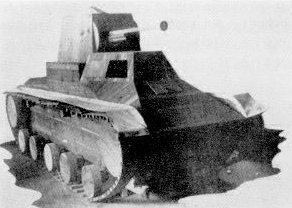Place of origin Empire of Japan Produced 1944 Length 4.07 m (13 ft 4 in) | Designed 1943/1944 No. built 1 (prototype) | |
 | ||
Weight 2.9 t (2.9 long tons; 3.2 short tons) for the tank, with wings added 4.2 t (4.1 long tons; 4.6 short tons) | ||
The Special number 3 light tank Ku-Ro (特三号戦車 クロ) (also known as the "So-Ra") was an experimental Japanese winged light tank project, developed during World War II.
Contents
History and Development
In the Fall of 1943, the Imperial Japanese Army's Teishin Shudan formed the 1st Glider Tank Troop. Before the 1st Glider Troop was established, the only heavy support available to Japan's airborne infantry, who otherwise would have only access to small arms, was provided by the Kokusai Ku-8. This military glider was able to transport the Type 94 and Type 94 75 mm mountain guns, but these infantry support guns lacked the mobility and anti-tank capabilities required by Japan's paratroopers. The solution to this problem was to develop a glider-portable light tank, but the existing Ku-8 glider was not capable of supporting the weight of a vehicle as large as a tank. So in 1943 and into 1944 the Armoured Army Headquarters (army aviation headquarters) and the Fourth Army Institute of Technology collaborated on authorizing a new concept to fill this role, a flying tank. A small tank that could be towed on a glider by a powered aircraft and then can be released and glide down to the battlefield along with paratroopers. The tank would detach its wings after landing and then be able to give armour support to the infantry. Rather than using an existing tank or gilder design, it was decided that a new tank and new glider should be developed. Work on developing the glider was given to Maeda Iron Works Company, while designing and building of the prototype was given to Mitsubishi.
Design
Mitsubishi based the tank on their Type 98 Ke-Ni light tank. The weight was reduced to 2.9 tons from 7.2 tons and the crew was brought down from 3 to 2. A single prototype was built and was named the 'Special number 3 light tank Ku-Ro'. The commander sat in the turret and acted as both gunner and loader. The driver's position was located in the chassis. The turret was rear-mounted and housed the tank's only weapon, a Type 100 37 mm tank gun, the same used by the Ke-Ni. There was no coaxial gun or hull mounted gun. There were plans to also mount either a flamethrower or 7.7 mm Type 97 machine gun in place of the tank gun. The glider developed for the Ku-Ro was the Maeda Ku-6 a 700 kg twin boom craft that was specially designed to fit the tank. When mounted in the Ku-6, the Ku-Ro had a wingspan of 22 m, a length of 12.8 m and a total weight of 4.2 tons. The glider was designed to be towed behind a Mitsubishi Ki-21 medium bomber. The tracks of the tank were unable to match Ki-21's take-off and landing speeds and since taking-off and landing would cause a great amount of damage from friction to the tracks, a pair of detachable skis were made part of the glider. The glider, after being launched and landing could quickly be dissembled and removed from the tank.
By 1945 the project was cancelled with only a single glider and tank built. This was caused by a combination of technical problems, related to the poor manoeuvrability of the glider and stress on the tank, and the changing nature of the war for Japan. The Pacific War was going poorly for Japan by 1945, the Japanese had already lost air supremacy to the United States Air Force and the chances of any large Japanese aircraft towing a glider being intercepted and shot down were very high and would mean not only the loss of the aircraft but the tank as well. In addition, with the continued Allied bombing of the Japanese home islands, Japan's industrial capacity and material resource stockpiles had begun to dwindle significantly, it was decided that military materiel could be better spent on more conventional weapons.
